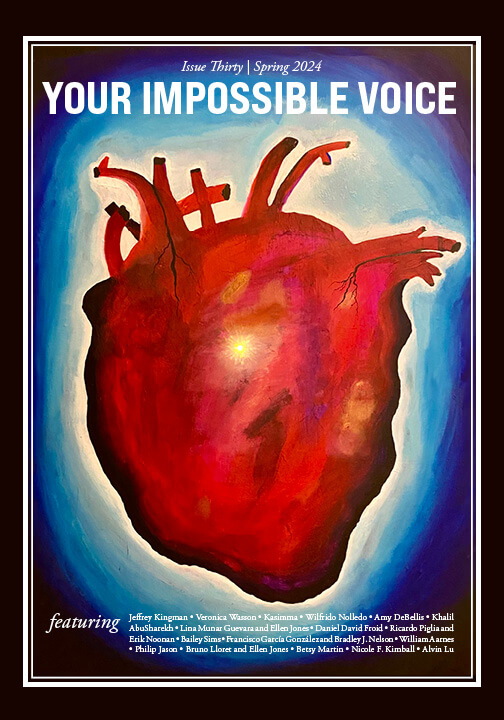Issue 30 | Spring 2024
The Tangled Mysteries or The Transmutation of Affection
Bruno Lloret
Translated by Ellen Jones
Another Family Heirloom
As I finish writing this, without knowing that I’m writing it, my mum gives me a gold crab on a chain:
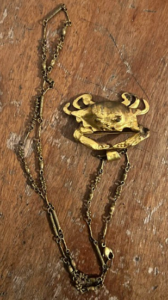
When I put it on, I realize it’s the first necklace I’ve ever had. I love it. It belonged to my grandparents, both of whom had Cancer as their star sign. I remember more than once seeing it around my grandmother’s neck. Now I’m getting used to the cold beat of its pincers against my chest. Whenever I can, I look at myself in the mirror and admire it. Then I put my hand in my pocket and touch another good luck charm, the one my grandfather gave me. Just as cold but this one’s made of silver.
Now I’m protected.
Not long ago it was the eleven-year anniversary of my grandfather’s suicide and the ten-year anniversary of my grandmother’s death. It’s been two years since I wrote a text to set them free.
This necklace is a protective seal, a gesture of reconciliation.
The crab has two pearls in each pincer. Between its protruding eyes, there is an infinity sign, which could be its nostrils:
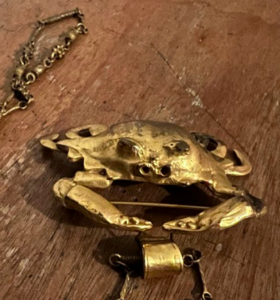
This infinity sign under its eyes, which I see whenever I lower my head to look at it hanging on my chest, is, perhaps, a good ending to The Tangled Mysteries.
The Invented Mystery of the Tarot of Marseilles
On a provincial train, I pull a card out of my pocket deck:
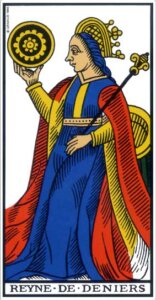
A Queen sitting on a goblet-shaped throne holds a coin, larger than her face, at head height in her right hand. Its thick, black concentric rings attract my attention as much as its rough flower design. Out of habit, I count things that appear multiple times on the card. As I count, something strikes me as strange: there are eight flower petals at the center of the coin. While I think about this and try to remember how many petals the flowers in the rest of the deck have, my eyes fall from the white background at the top of the card to a strange white slice: in the lower right corner, the Queen’s gown isn’t colored in. My eyes move left. The caption says: REYNE DE DENIERS. My eyes move right and I read the caption from back to front:
SREINEDEDENYER
When I read the other captions in the deck, I discover that this is the only card whose caption can be read in both directions. This fact, which I hope no one in the history of Tarot of Marseilles readings has ever mentioned, mellows a part of my mind that I can’t quite put my finger on.
Inside, I’m like a sun, laughing.
And there the mystery would be solved. It would be perfect and circular, like an infinity sign, and I’d have an anecdote to tell my friends, like someone who can do a really good magic trick.
But it doesn’t stop there. The sun inside me won’t let go.
The problem is: there’s an extra S, the same S that the strange absence of color in her gown seems to point to, right in the corner of the card. And that’s exactly what the ticket conductor, a relaxed looking middle-aged man, asks me: if there’s a problem. I look at him, shake my head, hand him our tickets, and raise my eyebrows. He looks at the little deck in my hands, at the card on my thigh, and asks me if I’m playing scopa. I say no, I’m reading my future. This time he’s the one to raise his eyebrows. “I want to know if we’re going to get married,” I explain, gesturing with my mouth to the creature opposite me, who is about to start snoring. The man checks the tickets, smiles nervously at the floor, and continues on his way. I am grateful for his disinterest and go back to concentrating on the Queen. To expand my awareness, I close my eyes and try to picture her. It doesn’t work particularly well, and thanks to the effort my migraine returns in painful throbs. I notice my back teeth grinding again, top against bottom, shifting side to side as the train rocks. I massage my temples to loosen my jaw. I breathe deeply and forget for a second about the mystery. Through the window there are rows and rows of twisted, leafless trees, most of them dried up from blight.
This country is a graveyard of olive trees.
Though it’s barely a few hours past midday, there are strange purple clouds moving in the distance. When they cover the sun for a few seconds and the light changes, I think, just as I did when I was a little girl, that it’s not the sun that changes, but rather my head, my brain, my eyes. The idea makes me nervous. I close the curtains and return to my problem, as though, by resolving it, my migraine might melt down my neck and over my shoulders until it disappears out through my belly button. I use the seat in front as a table. I count the petals on all the coins in the deck. The Queen’s is the only one with eight petals, and, not counting the Knight, the Knave, and the King, the rest of the coins have only four. I discard the possible problem of the other numbers. This is between the Queen and the coins, between the S and the 8.
Now I have a hunch as well as a problem. The hunch: could a coin with eight petals be worth two coins with four petals? The problem: what do I do with the extra S? I place all the Coin cards on the seat in front and meditate, my eyes unfocussed. I stare at the Two of Coins.
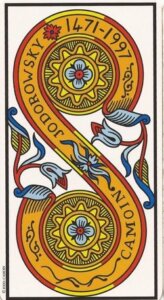
Around them, a caption in the shape of an S. Those two adjoined coins are the coin held by the Queen, a double coin.
I’m left thinking that the S, then, unlike the eight (8) petals or the shape of the eight (8), is the sign of almost-infinity.
I also think that, if there were a dual plural in French, it would be possible to know whether Coins means “many,” without specifying a precise number, or if it’s just a “couple” of coins. For this reason, because of the unique semantics of each tribe, I think I ought to leave the mystery here. Because of this, and also because I promised not to work, or rather I promised to rest—I’m not sure what the difference is, exactly—on this holiday. So I do all of the above quickly and guiltily, as though preparing to inject katamine on a Tuesday morning while babysitting a young nephew. By the time my partner opens his eyes, all the cards are back in the deck, inside their little box in my rucksack. He sees my guilty smile and asks what’s going on. Only when he attacks me with kisses below my ear and threatens to bite my neck do I say, alright, I’ll show you. I have to ask him to be patient when he rolls his eyes as I pull out the deck. “This is impressive,” I promise him. “This is real.” And I lay out for him the invented mystery of the Tarot of Marseilles, and with every new clue, every conclusion, we laugh with the delight of someone who has found a gecko with three tails, his face lights up and his eyes widen and the landscape outside, those leafless trees twisted like mummified corpses, and that strange sky, mutant like the fabric of my guts, all flee to some distant hideaway. The cards and the system we’ve discovered, visible now and alive, keep our pupils occupied. By the time we reach the final conclusion, we are both turned on, and we touch each other over our clothes without looking at any of the other passengers. At the end of the carriage, his foot in the doorway, the conductor is smoking a cigarette as he looks at the stone houses that line the track. As our tongues caress one another, sweetly, our mouths yoked together, I think about rest. The next four weeks are to be my first holiday in six years, and I don’t really know what to do with them. That, my gut tells me again, is the real Mystery.
The Mystery Revealed: X-rays, According to Dr. Fuentes
Once a year, Dr. Fuentes gets the whole Moya Clinic radiography team together to discuss x-rays. He wants them all to understand what happens at an atomic level when an x-ray is taken. Even though they hear it every year, nobody can really remember, and after asking and confirming what he already feared, Dr. Fuentes is irritated, irritated and disappointed. He cannot let the team function as though it were simply a magic trick.
“When we fire them at the chosen part of the body,” the doctor says, “the x-rays hit all the cells. That bombardment has the effect of aligning the protons in the atoms in each of the cells. They bounce off the film covered in silver salts to reveal the image. More solid elements, such as bones, bounce back a clearer image. Soft tissues, on the other hand, are more transparent. So we might say that an x-ray is the simultaneous alignment of all the protons in a group of tissues and bones.” The staff listen carefully. The doctor expects excitement at this explanation, but there is silence. He clears his throat. “Here’s an example: it’s as though, just before taking a photo, a photographer asks hundreds of thousands of people to say “cheese” and then, when he presses the shutter and the flash goes off, all those hundreds of thousands of heads turn at the same time to stare at the same spot, with the same expression, frozen in a moment that will last forever and will allow him, later, in the darkroom, to diagnose the state of that group of people as a society or community.” When he opens the floor to questions, there is silence. Nobody wants to ask anything. The doctor bows his head and goes back to his office without a word. The lights come on in the classroom, someone turns off the projector, and the staff return to their duties.
He walks down the corridor with one leg half-numb and both hands trembling slightly in the pockets of his lab coat. He has been very tired lately. He has to do a series of preventative x-rays for the national polo team: both the jockeys and the horses. He’s supposed to check over the jockeys this afternoon, but he wishes he didn’t have to. He’d rather do something worthwhile. So he turns up the volume on the radio and shows me, his young granddaughter who came to spend the day with him, because it’s the holidays and she adores him, his collection of strange x-rays. He’s been collecting them for years and wants to catalog and donate them to the University of Chile. His granddaughter asks what’s strange about them. Dr. Fuentes says nothing, but the bodies they show present anomalies. He shows her: “Here, here, and here; and if you look closely, here.” His granddaughter loves him, much more than I love him now that he’s gone, so she doesn’t want to say that she doesn’t understand. “How do you figure it out?” she asks. “I was trained to figure it out.” “How were you trained?” “In my head there’s a map of a perfect body. When I see an x-ray, I look for variations from the image I have in my head, and I write them down to describe the body: that’s a diagnosis.” Dr. Fuentes’s granddaughter is frightened by this idea. The music on the radio doesn’t help lighten the mood. A while later, she asks if he’s ever seen a perfect body like the one in his head. Dr. Fuentes says “No,” and then can’t stop thinking about it for the rest of the afternoon, while his granddaughter plays at writing checks in a bunch of old checkbooks.
The Circulating Mystery: Electrolysis
Once a year, Dr. Fuentes and his wife put all the x-ray sheets discarded by the clinic, cut up and in batches, into a hundred-liter pot. They then pour in over fifty liters of nitric acid and wait for the x-rays to disappear. The next day they set up a cathode and an anode and start the current flowing. Six hours later, the process of electrolysis has covered both the iron bars in silver deposits from the x-rays. Since they started, they’ve transmuted around fifty grams of silver a year. In their free time, Dr. Fuentes and his wife make pieces of jewelry with it. Silversmithing has made them feel close for the first time since they were married.
The Incomplete Mystery: The World is an S
“Snorri Sturluson was killed in Iceland because he was believed to be a traitor,” Dr. Fuentes says, burying his nose in a malt beer. “Ahh,” his granddaughter replies. “Do you like it?” he insists. “Yeah, his granddaughter replies, “it’s awesome.” “It’s yours,” the doctor says. “Seriously?” the granddaughter asks. “Of course.” But for the granddaughter it wasn’t so obvious. To her, this edition of the Prose Edda is the best present ever.
She reads the book when she gets home and learns the stories of the Norse gods, which blow her away. In the stories, transforming is easy. Everything changes shape. She remembers how, just a couple of years ago, she used to pass a church on the way to school so she could see its wooden Christ. The figure caught her attention because of the amount of blood gushing from its wounds. Once, she spent so long looking at it that she thought, for a moment, that the Christ was moving. She saw it move. The granddaughter had a fever, like the protagonist of the poem called “Völuspá: The Prophecy of the Seeress.” After remembering the moving Christ, she imagines a blond caveman burning with fever in a cave, imagining a future with no sun, a nuclear winter caused by a wolf who, after eating his own pups, ate all the lights in the sky.
Throughout the summer, she re-reads the book her grandfather gave her until she knows long stretches of it by heart. She wants to see him soon to talk about the stories. One afternoon, thinking about the time the god Thor lost three competitions because he was bewitched, the granddaughter invents a competition for herself: to peel a mandarin as perfectly as possible. She’s been trying for months, but something always goes wrong. Thor’s competitions encourage her to try again. She calculates: she’ll need a mandarin with a good peel, neither too loose nor too stuck to the segments, neither too thick nor too thin. She also needs a sharp thumbnail with a very precise curve. She’s been letting hers grow for two weeks and trying it out on mandarins. She realizes, when she picks it up, that this one is the perfect mandarin, that this could be the perfect peeling. She knows she can’t let her nerves get the better of her. She should start with her index finger at the base of the mandarin and use it to support her thumbnail, like a compass, and from there draw a consistent spiral.
When she finishes, she smells it, then puts it inside her copy of the Prose Edda and builds a tower on top of the book to flatten her experiment.
A month later she opens the book again and examines it carefully.
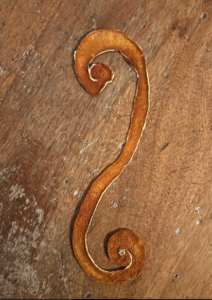
She places the peel carefully on the table, as though she were handling a mummy or one of the squashed frogs or geckos she collects, and evaluates it. Though it starts off really well, by the first turn after the straight line in the middle of the mandarin she got nervous and messed it up. It’s still beautiful, though. It’s the S-shape on a wooden instrument like a violin or viola. It’s a two-dimensional depiction of a three-dimensional object. A sphere in a volumeless world. She opens her eyes, understanding. She feels that this is an important discovery and that her grandfather will know it.
The Dynamic Mystery: “Metals either move …
or we move them,” Dr. Fuentes says to his granddaughter. “They’ve been sleeping forever inside the earth and we melt down mountains so we can have shiny pretty things, or to circulate energy or information.” They are crossing a road as he says his. The mountains are full of mines, hand-dug over two hundred years, with no help from machinery. You can see them, hidden and scattered among the stone walls and lines of cactuses. The miners were looking for gold and they found death. “Metals move, some become salts, those salts are compressed and made into x-ray films, aligned by rays fired at human bodies. When all the atoms align with the rays, the salts react and people’s insides are revealed on the films. While the images tell us what is going on inside people, the films accumulate as waste. I take them away from the clinic in a van and that’s how we recover the silver, which is made into jewelry or talismans.” When he says talismans, he adds: “like this one.”
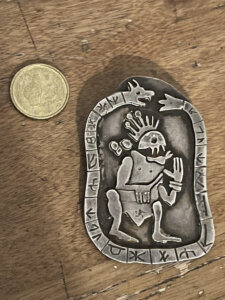
The granddaughter asks what it is. It looks like an Aztec or Maya god, but there are runes on the serpent surrounding the being on the medallion. “It’s the god Thor as a dwarf,” says Dr. Fuentes. “He’s surrounded by the serpent Jörmungandr. There are runes on the serpent. I invented some of them, others are real.” “And the talisman, what’s it for?” his granddaughter asks. “So you don’t lose your mind,” he replies. “So you understand that everything here moves, even the molten metals swirling at the center of the world.” The granddaughter feels, then, that this is the right moment. She pulls out the mandarin S out of the Prose Edda, shows it to him, and explains what she discovered. Dr. Fuentes listens to her with pride. “One day, this talisman will be yours,” he promises her. The granddaughter hugs him.
The Threshold Mystery: Lead on the Inside
When the lead burrowed into his skull, there was so little blood that his wife thought he’d bitten his tongue or fallen down drunk. The nurse said he had shot himself. She backed away, accidentally kicking her father’s pistol, a tiny German officer’s model from the First World War. She went into the kitchen, and as she put the kettle on to boil, she told the family. She was burning with rage.
“Metals move,” her granddaughter thought. She didn’t want to see the body. When they took him away in a blue body bag, she went into the room, stepped over the little puddle of blood, took the talisman out of the drawer in the bedside table, and put it in her jacket pocket.
That afternoon, as she receives visitors and their condolences, she peels twenty mandarins. None of them turn out well. The whole week, every time she has to look at someone, she puts her hand in her pocket and squeezes the talisman to give her strength, as her grandfather would have wanted.
About the Author
Bruno Lloret (1990) is a writer and researcher from Chile. He has published two novels, Nancy (Cuneta, Santiago de Chile, 2015; Giramondo 2019; Two Lines Press, 2020), and Leña (Overol, Santiago de Chile, 2018). He currently lives in New York.
About the Translator
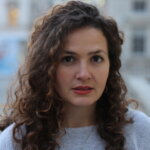 Ellen Jones is a writer, editor, and literary translator from Spanish. Her recent and forthcoming translations include This Mouth is Mine by Yásnaya E. Aguilar Gil (Charco Press, 2024), Cubanthropy by Iván de la Nuez (Seven Stories Press, 2023), and The Remains by Margo Glantz (Charco Press, shortlisted for the Warwick Prize for Women in Translation 2023). Her monograph, Literature in Motion: Translating Multilingualism Across the Americas is published by Columbia University Press (2022). Her short fiction has appeared in Litro Magazine, Slug and The London Magazine. You can find her at www.ellencjones.com.
Ellen Jones is a writer, editor, and literary translator from Spanish. Her recent and forthcoming translations include This Mouth is Mine by Yásnaya E. Aguilar Gil (Charco Press, 2024), Cubanthropy by Iván de la Nuez (Seven Stories Press, 2023), and The Remains by Margo Glantz (Charco Press, shortlisted for the Warwick Prize for Women in Translation 2023). Her monograph, Literature in Motion: Translating Multilingualism Across the Americas is published by Columbia University Press (2022). Her short fiction has appeared in Litro Magazine, Slug and The London Magazine. You can find her at www.ellencjones.com.
Prose
The Tangled Mysteries or The Transmutation of Affection Bruno Lloret, translated by Ellen Jones
Nova Veronica Wasson
Crying Spirit Kasimma
Diwata, Where She Walked Wilfrido Nolledo
Fake Moon Amy DeBellis
Zeppole (aka Awama) Khalil AbuSharekh
Excerpt from Imagine Breaking Everything Lina Munar Guevara, translated by Ellen Jones
Five Shots of Gay Sam, 2009-10 Daniel David Froid
Two Tales Alvin Lu
The Wall Ricardo Piglia, translated by Erik Noonan
Skinny Dipping Bailey Sims
Eight Quebecois Surnames Francisco García González translated by Bradley J. Nelson
Poetry
happy William Aarnes
i really love the little things that go unnoticed Philip Jason
College Jeffrey Kingman
The Desert Inn Betsy Martin
Cover Art
In the Heart of Love Nicole F. Kimball

